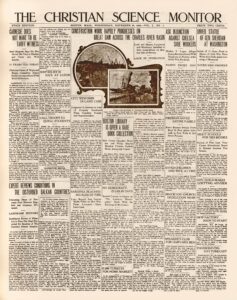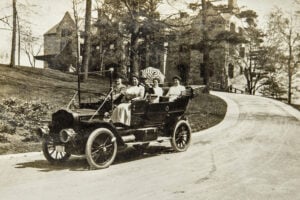Mary Baker Eddy’s final home at 400 Beacon Street in Chestnut Hill, Massachusetts, stands as a testament to a life of accomplishment and courage. This stately residence, which once again has opened its doors to the public, is a tangible reminder to the world of the stature that Mrs. Eddy attained—and for which she continues to deserve recognition and respect—as the Discoverer, Founder, and Leader of Christian Science.
When she boarded a private train bound for Boston from Concord, New Hampshire, on the afternoon of Jan. 26, 1908, Mrs. Eddy had never seen her new home. It had been purchased at her direction by an intermediary several months earlier. However, while she may have been embarking on a journey toward the unknown as far as her residence was concerned, she certainly wasn’t embarking on a journey toward quiet retirement. Far from it.
“I have much work to do,” she had told a newspaper reporter the previous summer. “I trust in God, and He will give me strength to accomplish those things which have been marked out for me to do.”1
We don’t know what she was thinking as the train steamed south through the snowy countryside that day. Perhaps of the work that lay ahead. Perhaps of the home she was leaving behind—Pleasant View, her country property on the outskirts of New Hampshire’s capital city. Her nearly 16 years there, though not without challenges, had been fruitful and happy. If she had regrets, she didn’t show it. One who accompanied her noted how impressed he was “with her cheerfulness rather than sadness, though doubtless it was not an easy experience for her to leave the home in Concord she loved so well.”2
Compared to the more modest lines of her New Hampshire farmhouse, the Chestnut Hill mansion seemed “a great barn of a place,” she confided initially to a member of her household.3 Originally built in 1880–81, the house had undergone a rapid renovation, doubling it in size in order to accommodate her growing staff of about 20. Much had been done to the interior prior to Mrs. Eddy’s arrival to make her new surroundings as familiar and comfortable as possible. The floor plan of the original wing had been modified to more closely resemble that of Pleasant View, for example, and some of the furnishings were old friends as well. Wallpaper and painted trim lightened and brightened the interior; carpet helped make it cozier. The fact remained, however, that 400 Beacon Street was vastly larger than Pleasant View. Her own suite she deemed unsuitable.
Changes would have to be made.
After a brief sojourn upstairs when she took over the seamstress’s third-floor rooms while her quarters were rebuilt—made smaller, to conform to the proportions she was accustomed to and preferred—Mrs. Eddy returned downstairs, rolled up her sleeves, and got to work.
What she would accomplish over the next three years evidenced her tireless capacity for labor and sealed her position as Leader. Founding a newspaper—The Christian Science Monitor—was in and of itself an achievement of a lifetime. In addition, she also established Christian Science nursing; authorized the first translation of Science and Health with Key to the Scriptures, her cornerstone work and the textbook of Christian Science, into another language (German); and published a new book, a collection of poetry titled Poems. She made hundreds of final revisions to her existing books, including Science and Health—some of which may have looked minor on the surface but went deep to the heart of the message. For instance, she modified two chapter titles—“Christian Science and Spiritualism” became “Christian Science versus Spiritualism,” and “Animal Magnetism” became “Animal Magnetism Unmasked.” In doing so, she definitively clarified their subject matter for present and future readers.
Additionally, while living in this house Mrs. Eddy skillfully navigated attempts to wrest control of her Church, thereby settling the succession question; fielded questions from the press with vigor and assurance; and produced a stream of pastoral letters, articles, and messages to her Church and the world. And with the addition of final By-laws to the Manual of The Mother Church, she solidified the structure that would carry the organization forward when she was no longer present to guide it.
During her years in Chestnut Hill, Mrs. Eddy came to love her new home, and we hope visitors today will love it, too. More than just a collection of vibrant wallpaper and carpet patterns, more than just the sum of its original furnishings and decorative objects—this house tells an important story of a life keenly attuned to and unfailingly obedient to God’s direction. It’s a story that Longyear loves to tell and will continue to tell for many years to come.
We hope you’ll take the opportunity to experience it for yourself.
Get information about visiting times and reserve a tour at this link.


